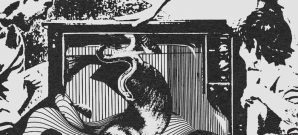 CocoRosie’s latest album, Grey Oceans, is their fourth to date. They remain true to the influences ascribed by many to their previous albums, but they ditch some of the lo-fi toy synthesizers and found sounds for a bit more of a polished sonic experience. The experience is in no way lacking in creativity and there is also no shortage of distinctive melodies, but the higher sonic quality may contribute to the conveyance of a deeper artistic maturity in this album.
CocoRosie’s latest album, Grey Oceans, is their fourth to date. They remain true to the influences ascribed by many to their previous albums, but they ditch some of the lo-fi toy synthesizers and found sounds for a bit more of a polished sonic experience. The experience is in no way lacking in creativity and there is also no shortage of distinctive melodies, but the higher sonic quality may contribute to the conveyance of a deeper artistic maturity in this album.
The opening track, “Trinity’s Crying”, is a hauntingly anticipatory introduction to the album. The distorted, ghost noise at the beginning is joined by the clarity of a tensely plucked string instrument, and as the song continues, new unexpected instruments enter the mix at strategic sectional points. These abrupt shifts work in the song’s advantage as, after the halfway point, the different sections start to switch back and forth rapidly as well as overlap with each other. The return of the sections and their interaction with each other serve to build the song’s energy to it’s ending.
CocoRosie, as on other albums, takes musical styles that we all know and exploit their characteristics to make something new. As Robert Hilburn said about Prince and David Bowie, they, “Used music chiefly as a backdrop for a larger purpose: to celebrate the freedom of the individual.” While CocoRosie may not exactly purpose the same thing, there is certainly a sense that the act uses music to point to something beyond itself. They hold up for us to see the clichés of accepted musical genres by using them in new ways, combining them in unlikely combinations, and by using them to set lyrics that wouldn’t normally be sung over that musical style.
The many influences jumbled together by this duo could be listed, as CocoRosie’s Wikipedia page reads: pop, blues, opera, electronica, and hip-hop. The classical influence in CocoRosie’s music is most clearly heard in Rosie’s trained, soprano voice. In a few of the songs, such as the already hymn-like, title track “Grey Oceans”, Rosie sings a high descant over Coco’s lead melody. Coco’s voice is strange, but demands the attention that a ‘typical’ female singer-songwriter usually fails to get. Rosie’s high sustain can be heard in other tracks lending an ancient and mysterious element amid electronic beats and synthesizers such as in the song “Fairy Paradise”. “Smokey Taboo” has a sparse, Indian dance beat, with verses sung in a hip-hop rhythm. It seems to poke fun at Indian flavored hip-hop like Sean Paul and Beyonce’s “Baby Boy”. But it rises above the category of satire because the lyrics are cohesive and interesting, and the music is enhanced by harp and classical vocal lines over and between verses. The half charming and half sorrowful “Hopscotch” has a lightening speed break beat heard behind honky-tonk piano at one point and more congruent synth pads at another. The song’s character shifts between childlike and serious, but it’s the juxtaposition of clichés such as honky-tonk and break beats that asks the listener to recognize the elements for what they are. The two musical genres are pitted against each other and still identifiable. Middle Eastern, baroque hip-hop might be the best way to describe “The Moon Asked the Crow”. The chorus diverges to an ethereal character and we hear about some strange drama between the moon and a crow, but it seems unrelated both musically and lyrically from the hip-hop verses that contain stream of consciousness poetry about first, a graveyard, then, an angelic brother.
Other songs stand more simply on their own premises without combining clearly divergent musical genres. “Undertaker” is a beautiful piano based song that has harmonic characteristics similar to Sufjan Stevens’ (QRO live review) “The Seer’s Tower”. The relaxed beat and constantly morphing soundscape of “R.I.P. Burn Face” is a wonderful example of CocoRosie’s use of sound as the main focus of a song’s development. “Gallows” contains some of the atmospheric sounds that are more present on pervious albums, and, with the help of those sounds, it tells a truly gripping and darkly magical though vague tail of an execution.
CocoRosie’s obscure lyrics range from minimalist repetitions to stream of consciousness to abstract imagery sometimes all in the same song. The lyrics are reminiscent of the captivatingly abstract poetry of modern poets such as Gabriel Garcia Marquez and Rainer Maria Rilke – beautiful words that move from one fantastical non sequitur image to another. Finding these highly emotional, abstract words skillfully set over hip-hop, honky-tonk, and hymn music – places that these lyrics are not native too – contributes to the effect that CocoRosie often have of turning clichés on their ears. The weakness of such abstract lyrics is that, at times, they don’t say much about most people’s lives because sometimes they just sound pretty and don’t seem to mean anything. In CocoRosie’s defense, their lyrics are always at least beautiful sounding and sung very well.
The album is full of pretty melodies, interesting arrangements, and lyrics whose poetic depth is stronger than most in popular music of any kind.
MP3 Stream: “Hopscotch”



















